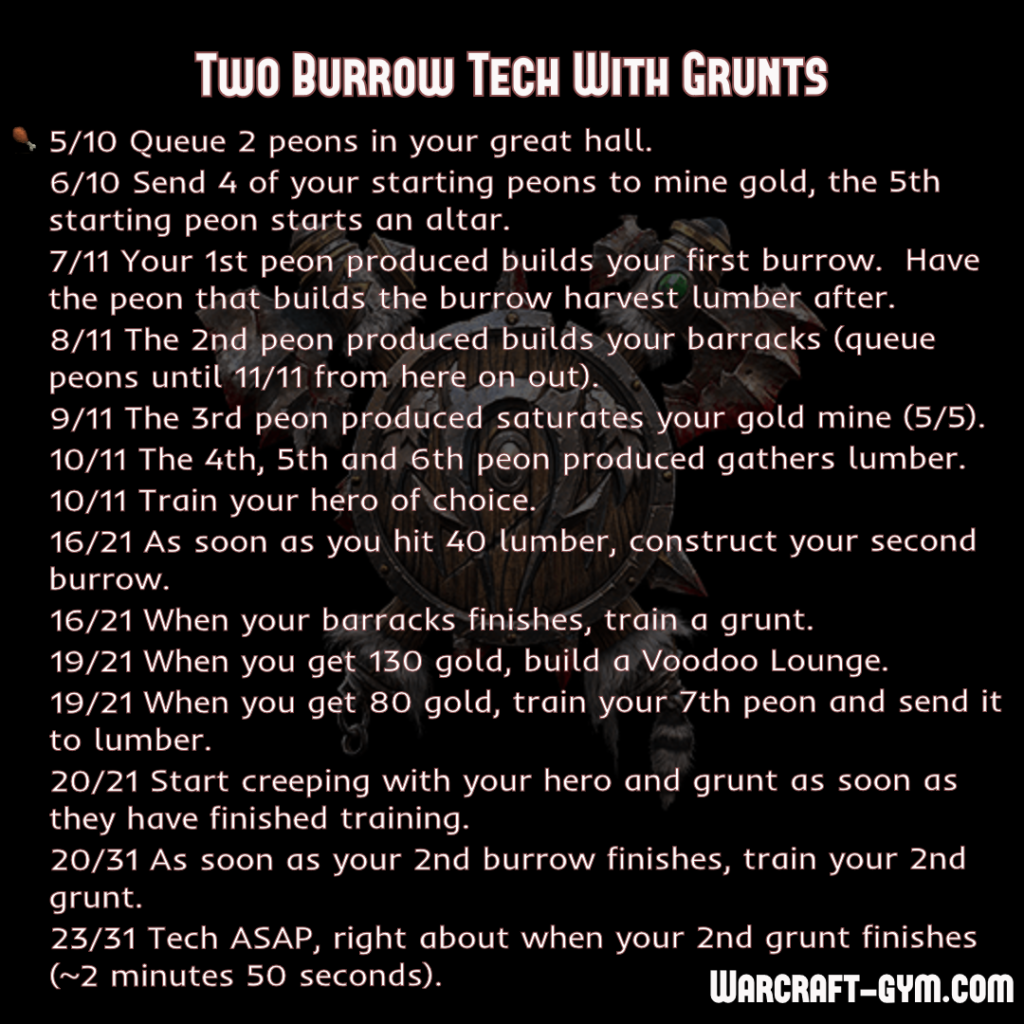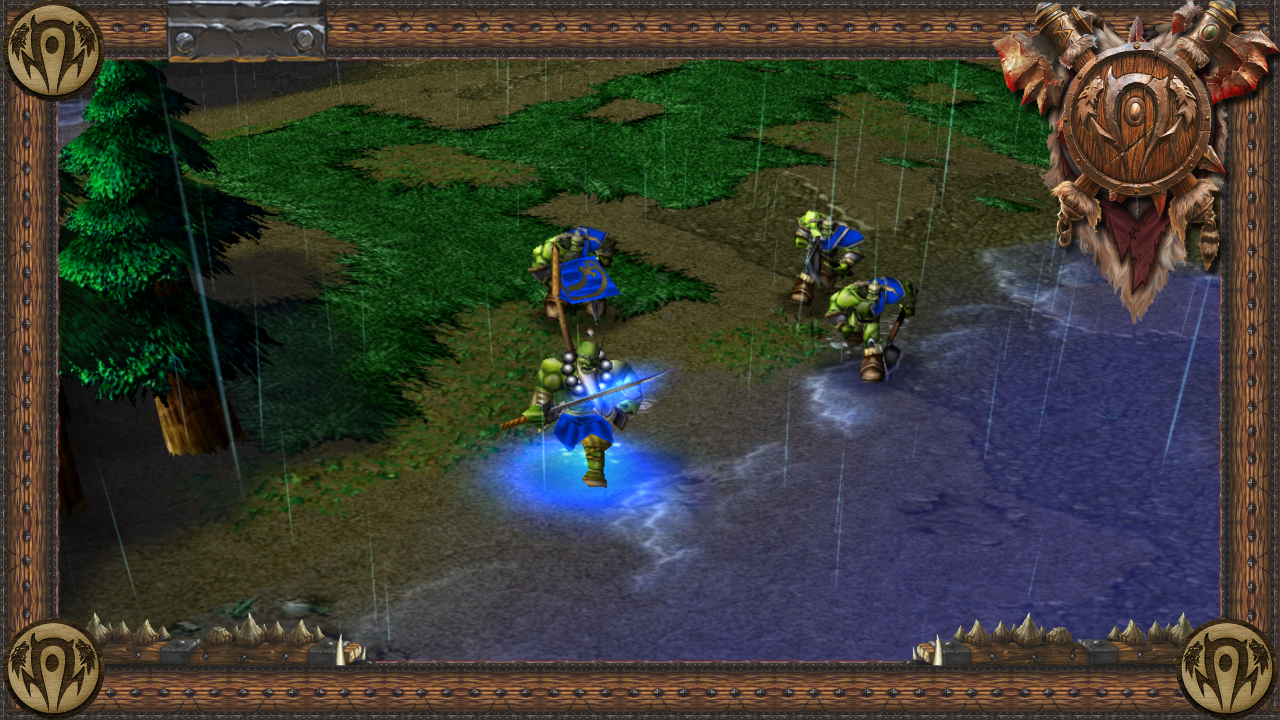The two-burrow tech with grunts (or just two-burrow tech for short) is as its name suggests a variation of the one-burrow tech build-order where you build your second burrow before teching instead of afterwards, and is most commonly used in the mirror and vs. Night Elf matchups. Despite being viewed as the lesser of the two (or worst of them all, because of its comparatively abysmal tech speed coupled with not investing in headhunters) it supports an alternate game-plan where you focus on improving your early-game power through creeping instead of disrupting your opponent’s early-game to make way for your second hero.
Your second burrow is also a lot less exposed to early aggression in this build-order compared to one-burrow teching. This coupled with the fact that you usually make four grunts instead of three during your tech to Tier 2 makes early harass and eventual tower-rush attempts a lot easier to deal with. Your early second grunt can also help you scout out key positions and cover your opponent’s options in terms of creeping. The less reactive playstyle and the added early-game safety are two reasons why this build-order often gets recommended to beginners.
Difficulty of Build: Easier to get into and potentially less punishing than one-burrow teching, but gets harder to execute the stronger your opponents get.
Pros:
- Safety and simplicity.
Cons:
- The slow tech speed and investment into the early-game puts you really far behind by default. You will have to recognize this fact and try to snowball off your creeping.

Late Game Transitions:
As this build-order is very similar to the standard one-burrow tech we suggest that you take a look at that tutorial for some references in terms of compositions and general strategy if you’re just starting out. At a higher level of play we only really see this build utilized in the mirror and vs. Night Elf matchups played with either a Blademaster or Shadow Hunter first, so we will only cover those two matchups in detail.
vs. Human- You will always creep slower than the Human player, you cannot counterexpand vs. the Human player, you will have trouble pressuring the Human player. If you stick to a gameplan that revolves around getting your first hero to 3 as fast as you can with grunts vs. Human you’ll quickly find yourself losing at early Tier 2; not being able to finish construction of your Spirit Lodge and getting your second hero killed in long drawn fights at level 1. Even if you keep pressuring them from start to finish in the early game, it’s more than likely that the Human player is going to end up ahead because of your slow tech. We recommend a two-burrow tech with headhunters instead (for the pressure), or a faster one-burrow or no barracks tech.
vs. Undead- Unlike vs. Human there are a lot of arguments for boosting the creeping of your first hero vs. fast Death Knight. Both the Blademaster and the Far Seer (in particular) can exert a lot of pressure on the opponent if they hit Level 3 early, and if they aren’t careful they could get punished heavily because of the scouting/lack of dispel which could result in a game-winning lead. However, this is not for certain. What is certain is that you are delaying your second hero and a shot at Tier 3 for a safer, slightly more creeping efficient early game. An experienced Undead player will take advantage of this either by all-inning you early Tier 2; fast-expanding; or if you fail in your task of completely halting his midgame creeping with a single hero, a Tier 3 timing. We recommend the one-burrow tech or the more META aligned Far Seer/Headhunter build, but you could definitely get away with playing a two-burrow tech vs. Undead.
vs. Orc- Two-burrow teching with grunts is probably most frequently deployed in the mirror matchup, where its comparatively small boons in creeping and safety across the other matchups increase in value. In mirror you will most often encounter your opponents playing either a Blademaster one-burrow tech or a Far-Seer two-burrow tech with Headhunters, and the two-burrow tech with grunts has the potential to act as a great blanket strategy for both of them. It’s niche, but a player who realizes and utilizes the strengths of the build can find great success in playing it.
You usually play with a Blademaster first and a Shadow Hunter second, but if you’re feeling creative in the choice of your first hero you could try playing Shadow Hunter first as well. The additional early-game safety and creeping support do make more of a difference in mirror than in other matchups, and the unusual strategy could catch lazy opponents by surprise. It is not suited vs. a Far-Seer first though as the almost instantaneous early game pressure gets way too hard for the Shadow Hunter to handle.
- Blademaster/Shadow Hunter
This is the most common and successful way of playing two-burrow tech grunts. The idea is to use your superior creeping ability to outperform your opponent (who most likely is going to be one-burrow teching, sacrificing creeping speed and early safety), reaching level 3 with your Blademaster, and in an ideal situation abusing that powerspike when your opponent reaches Tier 2. This play has the potential to win you the game straight away (it goes both ways!) since your goal is to repeatedly cancel your opponent’s Beastiary/Tauren Totem, effectively grinding his game to a halt by locking him out of his tech and forcing his entire army (two heroes, three grunts) to stay in his base. Windwalk 2 offers an additional 15 seconds of invisibility, which means 15 more seconds of Healing Salve, which means that you can keep doing this for a while (the additional movement speed helps in getting away as well). Your opponent can of course get Dust of Appearance and force you to disengage but if he lets you get away with this without doing any economical damage of his own the game is probably over. By then your delayed Shadow Hunter should have finished creeping a risky creep camp with the extra fourth grunt unpunished and put you miles ahead of them.
This situation is of course imaginary (but not impossible), and things might not always work out in this particular way. Since creeping is map dependent it’s very likely that results will vary, not to mention the fact that you might face the same situation if your opponent catches on and creepjacks you after you’ve started to creep something greedy; the reason why one-burrow teching is considered to be the better Blademaster strategy. You are behind in tech by default after all, and you have to make up for the difference.
If the game isn’t over/early game went even you have the choice of risking a transition into Tier 3 with Tauren Chieftain/Tauren/Master Walker/Orb of Lightning to further your advantage or staying at Tier 2, playing a standard game. As for facing the Far Seer, two burrow teching with grunts has the advantage of being better suited to deal with the Tier 2 Firelord tower-push than the one-burrow tech is. In this situation you’ll have to try to stop the Far-Seer from leveling and thus abandon the gameplan used vs. Blademaster one-burrow tech. For more specific transitions and counter-strategy, I will refer to our “Standard one-burrow tech with shop” tutorial. I will also link a series played by Hitman where he uses two-burrow teching vs. a one-burrow build on CH in a similar manner as I’ve described above.
- Shadow Hunter/Pit Lord
Although this strategy carries a lot of weaknesses compared to playing Blademaster first, it can make up for it in raw power when you manage to play around them. The idea is to go Shadow Hunter first instead and getting him to level 3 in the early game so that you unlock Serpent Wards/Healing Wave level 2 earlier, giving you a significant edge in long drawn engagements until he has done the same. You will then go for a Pit Lord second and creep him up to the best of your ability, as Cleave has the potential to absolutely decimate Orc armies. Your unit composition will look more or less the same as if you were playing Blademaster/Shadow Hunter, going for the standard Grunt/Raider/Walker/Kodo on Tier 2 and adding Master Walker/Tauren if you’re going Tier 3.
The Shadow Hunter is very susceptible to early harass and if an equally skilled opponent decides to play Far Seer first it might very well spell your doom, making this strategy better suited against Blademaster players. Unlike the Blademaster, Shadow Hunter also doesn’t really have any significant power-spikes or use until he is level 3, which makes the strategy a lot more map-dependent. Can win or lose you the game in a heartbeat, play at your own risk.
vs. Night Elf- Competitive Orc vs. Night Elf is usually played with a Blademaster/Shadow Hunter one-burrow tech, but the aforementioned Shadow Hunter/Pit Lord strategy carries potential vs. Night Elf as well. Serpent Wards level 2 are insanely strong vs. the Night Elf unit roster and since your opponent’s early game goals usually revolve around hitting level 3, the risk of your own creeping getting harassed is lower than in the mirror matchup.
Strong Night Elf players will most likely creep faster than you though, which can lead into a game-losing situation at early Tier 2. You can play the same unit composition as you do in mirror, but vs. the Keeper of the Grove you probably want to switch your Tauren Totem for a Spirit Lodge in favor of training Shaman.
Here are 2 more videos that show SH/PL strategy mentioned above.
